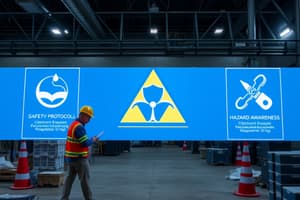Podcast
Questions and Answers
What does Norton emphasize about safety courses?
What does Norton emphasize about safety courses?
- Relying solely on in-house safety training
- Taking advantage of safety courses like TCIA’s EHAP courses (correct)
- Ignoring the importance of safety courses
- Avoiding safety courses provided by utilities
What does Norton suggest about establishing a relationship with the local utility?
What does Norton suggest about establishing a relationship with the local utility?
- Relying solely on personal judgment near utility wires
- Establishing a good relationship with the local utility (correct)
- Avoiding any contact with the local utility
- Seeking legal action against the local utility
What does Norton mention about the actions of utilities in hazardous situations?
What does Norton mention about the actions of utilities in hazardous situations?
- Utilities charging for any assistance provided
- Utilities only addressing service wire issues
- Utilities ignoring hazardous situations
- Utilities taking down primary wires to facilitate tree work (correct)
What is emphasized about the attitude of utilities towards safety?
What is emphasized about the attitude of utilities towards safety?
What is the analogy used to explain step potential?
What is the analogy used to explain step potential?
How is the highest voltage described in the analogy of step potential?
How is the highest voltage described in the analogy of step potential?
What is the risk associated with stepping into two different voltage zones?
What is the risk associated with stepping into two different voltage zones?
Why does depth perception add to the danger of an elevated, dangling power line?
Why does depth perception add to the danger of an elevated, dangling power line?
What does OSHA's '10-foot rule' specify in relation to power lines?
What does OSHA's '10-foot rule' specify in relation to power lines?
What is a key requirement for crane operations in relation to electrical lines?
What is a key requirement for crane operations in relation to electrical lines?
What is emphasized as crucial in tree care and crane operations?
What is emphasized as crucial in tree care and crane operations?
What is the stance of crews towards unsafe jobs?
What is the stance of crews towards unsafe jobs?
What is a growing practice in the tree industry in relation to crane operations?
What is a growing practice in the tree industry in relation to crane operations?
What do climbers need training in, according to the text?
What do climbers need training in, according to the text?
What is the role of utility companies in relation to EHAP programs?
What is the role of utility companies in relation to EHAP programs?
How should tree care company owners treat utility companies?
How should tree care company owners treat utility companies?
What is essential to protect employees in tree care and crane operations?
What is essential to protect employees in tree care and crane operations?
What does the intersection of tree care and crane operations require?
What does the intersection of tree care and crane operations require?
Study Notes
Safety Protocols in Tree Care and Crane Operations
- OSHA rules mandate a designated spotter to monitor electrical lines and communicate with crane operators.
- Teamwork and adherence to safety rules are crucial in tree care and crane operations.
- OSHA's "10-foot rule" designates a 20-foot distance from unknown voltages, emphasizing the importance of recognizing power lines and maintaining safe distances.
- Crews prioritize safety and are willing to walk away from unsafe jobs, even if it affects profits or requires rescheduling.
- Commercial tree care companies face unpredictability when working with trees and electricity.
- Crane operators require training to handle electrical hazards and stabilize loads, especially in the absence of precise weight information for tree limbs.
- Training arborists to run cranes is a growing practice, but it requires adaptation to the tree industry's unique operational methods.
- Climbers also need training in electrical hazard awareness programs (EHAP), offered through organizations like TCIA.
- Utility companies collaborate in running EHAP programs to ensure proper training for tree care workers.
- Tree care company owners should prioritize employee training and treat utility companies as allies for safety.
- Safety protocols are essential in tree care and crane operations to protect employees, emphasizing the need for ongoing training and cooperation with utility companies.
- The intersection of tree care and crane operations requires a deep understanding of safety measures and training for all involved parties.
Studying That Suits You
Use AI to generate personalized quizzes and flashcards to suit your learning preferences.
Description
Test your knowledge of safety protocols in tree care and crane operations with this quiz. Learn about OSHA rules, electrical hazard awareness, the importance of teamwork, and the need for ongoing training to ensure the safety of workers in this industry.




